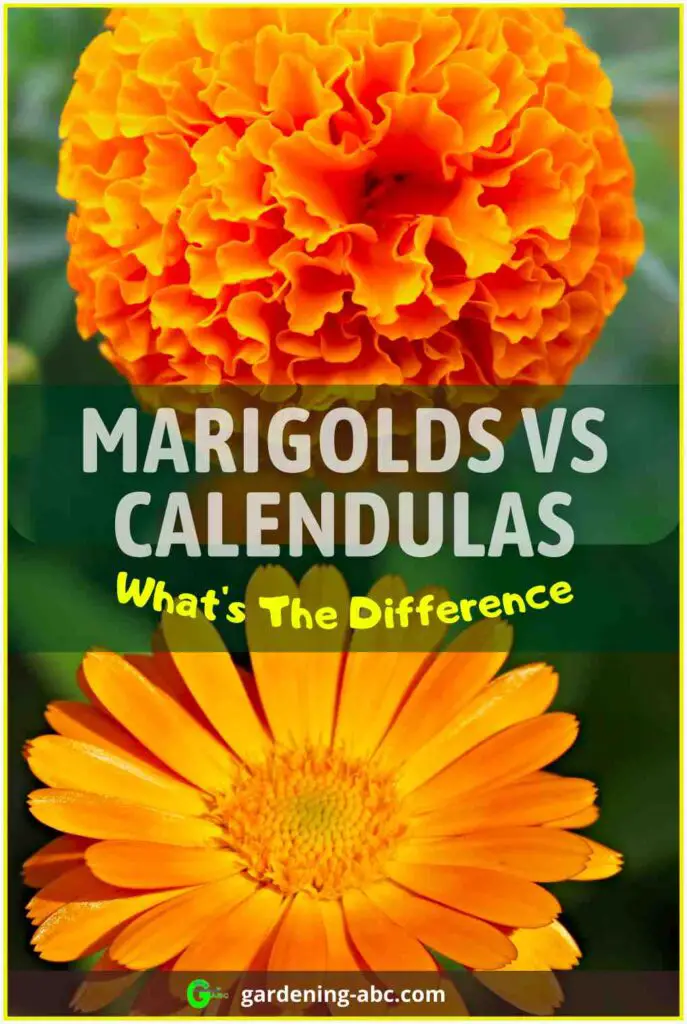We use affiliate links to run our site. When you buy through links on our site, we may earn an affiliate commission, without any added cost to you. Learn more
When deciding which flower to grow in your garden, Marigolds and Calendula have become two of the most popular options.
Both of these flowers bring beauty and color to any environment, but there are also some significant differences between them. Knowing what sets them apart can help you make the best decision for your garden.
In this article we will discuss the differences between Marigolds and Calendulas to help you determine which is the right choice for your garden.
Marigold and Calendula are both members of the Asteraceae family and are often used interchangeably.
Both plants grow easily in hot weather and bloom from late summer to fall. Both produce large, bright yellow flowers with many petals.
Although calendula is sometimes called “pot marigold,” it is not a true marigold plant. Each of them has its own beauty, and it is actually quite easy to distinguish between the two.
The importance of understanding the differences between Marigold and Calendula:
There are several reasons why it is important to understand the differences between Marigold and Calendula.
First, Marigold and Calendula are often confused with each other due to their similar physical appearance and the fact that they belong to the same botanical family. However, they are actually two distinct species with different scientific names, characteristics, and uses.
Understanding the differences between these two plants can help you identify and distinguish them accurately.
Second, Marigold and Calendula have different culinary and medicinal uses. Marigold is sometimes used as a natural food coloring and flavoring agent, while Calendula is commonly used in herbal remedies for its potential health benefits.
Understanding the specific properties and uses of each plant can help you make informed decisions about incorporating them into your diet or healthcare routine.
Third, Marigold and Calendula also have different cultural and symbolic significance.
Marigold, for example, is a popular flower in many cultures and is often associated with celebrations and festivals. Calendula, on the other hand, has a long history of use in herbal medicine and is often symbolically associated with healing and wellness.
Understanding these cultural and symbolic associations can enrich your appreciation and understanding of these plants.
Finally, knowing the differences between Marigold and Calendula can also be helpful in gardening and landscaping.
Both plants are popular garden flowers and can be used in a variety of landscaping designs. However, they have different growing requirements and can thrive in different climates and soil types.
Understanding the specific needs of each plant can help you choose the right one for your garden and ensure its success.
What is A Marigold?
Marigold (Tagetes spp.) is a flowering plant that is native to the Americas and belongs to the sunflower family (Asteraceae).
It is known for its bright and showy flowers, which can range in color from yellow and orange to red and white.
Marigold is widely cultivated as a garden flower and is also used in traditional cooking and herbal remedies.
What is a Calendula?
Calendula (Calendula officinalis), on the other hand, is a perennial herb that is native to the Mediterranean region and belongs to the daisy family (Asteraceae).
It is known for its small, bright yellow or orange flowers and has a long history of use in herbal medicine. Calendula is also sometimes used as a natural food coloring and in cosmetics.
The Differences Between The Marigold and The Calendula:
The followings are the main differences between The Marigold and The Calendula or “The Potted Marigold”.
Names:
The first thing you will notice is being different plants, they have different botanical names.
Marigolds comes under the genus Tagetes. some of the most popular marigold varieties are
- African marigolds: Tagetes erecta.
- French marigolds: Tagetes patula,
- Mexican marigolds: Tagetes lucida. and
- Signet marigolds: Tagetes tenuifolia.
Calendula plants come under the genus Calendula. And the most popular calendula variety is known as Calendula officinalis
Size:
Marigold and Calendula can be distinguished by their flower size. Marigold flowers are larger and more showy, while Calendula flowers are smaller and more delicate.
Marigold plants can vary quite extensively in their sizes. They can be quite short up to 6 inches or can go very tall 4 ft. Calendula generally grows up to only 24 inches tall, with a similar spread.
Shape:
Calendulas have long, rounded leaves. if you touch the leaves they will have a sticky and hairy texture.
Marigolds on the other hand have long, thin leaves that are toothed on the edges. The stems of the marigolds are smooth to the touch.
Scent:
Calendula has a slightly sweeter smell compared to marigolds. The marigolds have more of a pungent smell that many people find unpleasant.
Seeds:
Calendula seeds are curved in shape and look more like a crescent. They also have little ridges and are brown in appearance.
Marigold seeds are straight and black with a white tip.
Toxicity:
Calendulas are not toxic, the petals are commonly used in food preparation in place of saffrons.
Marigolds are mostly inedible and toxic to pets. They contain phototoxic thiophene derivatives that can cause problems if ingested in excess amounts.
Ideas for incorporating these plants into landscaping designs:
Marigolds and Calendula are both popular garden flowers that can add color and interest to landscaping designs. Here are some ideas for incorporating these plants into your landscaping:
- Use them as border plants: Marigolds and Calendula make excellent border plants due to their bright and showy flowers. Plant them along the edges of beds or borders to create a colorful frame around your garden.
- Plant them in containers: Both Marigold and Calendula are well-suited to container gardening, making them a great choice for small spaces or balconies. Plant them in pots or hanging baskets to add pops of color to your outdoor living areas.
- Plant them in mass: Planting marigolds and Calendula in mass can create a stunning visual impact. Consider planting them in large drifts or groupings to create a sea of color in your garden.
- Use them in cut flower arrangements: Both Marigold and Calendula make beautiful cut flowers and can add a natural and vibrant touch to indoor arrangements. Consider planting a patch of these flowers specifically for cutting and bringing inside.
- Incorporate them into a cottage garden: Both Marigold and Calendula have a casual, informal feel that makes them well-suited to cottage garden styles. Plant them alongside other informal flowers, such as daisies and foxgloves, for a charming and romantic look.
By using these plants in a variety of ways, you can add color, interest, and beauty to your landscaping designs and create a garden that is both functional and aesthetically pleasing.
Some Useful Growing Tips:
Here are some tips for growing Marigold and Calendula in your garden:
- Choose the right location: Both Marigold and Calendula prefer well-drained soil and full sun, although Calendula can tolerate partial shade. Avoid planting them in areas that are prone to standing water or heavy shade.
- Prepare the soil: Both plants prefer well-draining soil that is rich in organic matter. To improve the soil, mix in compost or well-rotted manure before planting.
- Plant at the right time: Marigold and Calendula can be planted from seeds or transplants. In most climates, it is best to plant them in the spring or early summer after the threat of frost has passed.
- Water regularly: Both plants need regular watering, especially during dry spells. However, be sure to avoid overwatering, as this can lead to root rot.
- Fertilize occasionally: Marigold and Calendula do not require heavy fertilization, but a light application of balanced fertilizers every few weeks can help encourage growth.
- Deadhead: Removing spent flowers (deadheading) can encourage new blooms and keep the plants looking neat and tidy.
- Protect from pests: Both Marigold and Calendula are generally resistant to pests, but they can be vulnerable to slugs and snails. To prevent damage, use slug bait or copper tape around the base of the plants.
conclusion
Although both plants have yellow or orange flower heads they are not the same plant and you should never substitute one for another. While Clendulas are better for edibility, Marigolds can serve as an effective insect repellent.
I hope this post has been able to resolve the doubts about marigolds and calendulas.
If you like the information, share it with others, and Don’t Forget to PIN IT.

Amazon and the Amazon logo are trademarks of Amazon.com, Inc, or its affiliates.

Hi there! My name is Prasenjit and I’m an avid gardener and someone who has grown a passion for growing plants. From my hands-on experience, I have learned what works and what doesn’t. Here I share everything I have learned.
